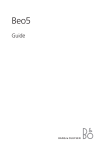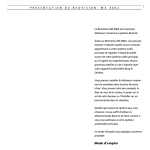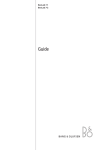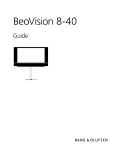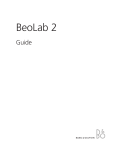Download Bang & Olufsen BeoLab 4 Specifications
Transcript
BeoLab 4 Guide CAUTION RISK OF ELECTRIC SHOCK DO NOT OPEN CAUTION: To reduce the risk of electric shock, do not remove cover (or back). No User-serviceable parts inside. Refer servicing to qualified service personnel. WARNING: To reduce the risk of fire or electric shock, do not expose this appliance to rain or moisture. Do not expose this equipment to dripping or splashing and ensure that no objects filled with liquids, such as vases, are placed on the equipment. To completely disconnect this equipment from the AC Mains, disconnect the power supply cord plug from the AC receptacle. The lightning flash with arrowhead symbol within an equilateral triangle, is intended to alert the user to the presence of uninsulated “dangerous voltage” within the product’s enclosure that may be of sufficient magnitude to constitute a risk of electric shock to persons. The exclamation point within an equilateral triangle is intended to alert the user to the presence of important operating and maintenance (servicing) instructions in the literature accompanying the product. Daily use When you have finished setting up the loudspeakers as described on the following pages, connect the entire system to the mains. The indicator lights turn red, to indicate that the loudspeakers are in standby mode, ready for use. The loudspeakers are designed to be left in standby mode when not in use. Cleaning the loudspeaker The speaker panels may be cleaned with a vacuum cleaner set to the lowest suction level. Clean the other surfaces using a soft, lint-free cloth which you have dipped in lukewarm water and wrung firmly. 3 Switching on and off When you switch on your system, the loudspeakers switch on simultaneously, and the indicator lights turn green. Indicator light When you switch off your audio (or video) system the indicator lights turn red. However, if the loudspeakers are connected to a computer – via the LINE IN socket, and with the LINE IN switch set to PC – they will not switch to standby. Refer to ‘Cable connections’ (pp. 6–7). Indicator light: In daily use the indicator light shines either red (standby) or green (playing). Never use alcohol or other solvents to clean any parts of the loudspeaker! NOTE! Prolonged listening at high volume levels may cause hearing damage. 4 Set up the loudspeakers We recommend that you follow this procedure: – Disconnect your system from the mains. – Connect the loudspeakers and set the LINE IN–POWER LINK switch on each loudspeaker as explained in ‘Cable connections’ (pp. 6–7). – Set the POSITION switch to the correct setting on each loudspeaker. This is explained in ‘Adapt the loudspeaker to your room’ (pp. 8–10). – Connect the entire system to the Cautions mains again. – Make sure that the loudspeakers – For optimum sound quality, do not are placed and connected in place the loudspeaker enclosed in, The loudspeaker must be placed accordance with the instructions for example, a small bookcase. standing upright on its base, or in this Guide. To prevent injury, Leave a minimum of 20 cm (8") fastened to one of the optional use Bang & Olufsen approved free space at the sides, and never accessories. Make the connections, stands and wall brackets only! place anything directly in front of and set both switches before you – The loudspeaker can only be the loudspeaker. fasten the loudspeaker to one of the switched off completely by – Do not block the sound emitting accessories. disconnecting it from the wall from the bass reflex port at the socket. bottom of the loudspeaker. – Do not attempt to open the loud- – Place the loudspeaker with its speaker. Leave such operations to front (the Bang & Olufsen name qualified service personnel! The plate) facing your favourite speaker panels, however, may be listening position. removed for cleaning. – The loudspeaker is designed for indoor use in dry, domestic environments only, and for use within a temperature range of 10–40º C (50–105º F). 5 Loudspeaker front and side panels With each loudspeaker you will get one front panel and two side panels. These panels must be fastened to the loudspeaker before use. The front panel is marked with a Bang & Olufsen name plate. Each of the panels have three small pegs on the rear. A B A A Fasten the panels by inserting the three pegs into the corresponding holes (A–B) in the front and the sides of the loudspeaker. B B Ceiling Bracket: This optional accessory has a hidden lock, which must be released before you can detach the loudspeaker from the ceiling. Note: The product identification and CE labels are placed on the loudspeaker body behind the side panels. Use a small screwdriver, for example, to push the lock inwards, while turning the loudspeaker counterclockwise until it is free. 2 3 1 Cable connections 6 The loudspeakers can be used with Bang & Olufsen audio, video and link systems. They may also be used with nonBang & Olufsen audio or video systems, or connected to a computer. About the two switches … The POSITION switch has three settings. Which setting to use depends on the position of the loudspeaker. This is explained in ‘Adapt the loudspeaker to your room’ (pp. 8–10). The LINE IN–POWER LINK switch serves two purposes. If the loudspeaker is connected to the system via the LINE IN socket, it switches between two line input levels. If connected via the POWER LINK socket, it switches between the right and left sound channel. LINE IN ~ POWER LINK POSITION LINE PC 3 2 1 RIGHT LEFT The sockets and the two switches are located in the base of the loudspeaker. - LINE IN - POWER LINK Connection to Bang & Olufsen systems Use Power Link cables to connect the loudspeakers to your system. Set the POWER LINK switch to RIGHT or LEFT, the right and left sound channel, respectively. … To a personal computer Use a special connector to connect the computer sound card output to each of the LINE IN sockets on the loudspeakers (the connector is available as an optional accesory from your Bang & Olufsen retailer). Set the LINE IN switch to PC. Connection to non-Bang & Olufsen systems … … To audio or video systems Connect the system to the LINE IN socket on each loudspeaker (minijack – mono). Set the LINE IN switch to LINE. When set to PC, the loudspeakers will not automatically switch to standby mode when the sound signal disappears. In this case, we recommend that you switch off at the wall socket, when not using the computer. 7 Power Link connections: These connections carry both the right and left sound signals. Therefore, you can: 1 Run a Power Link cable from the Bang & Olufsen system directly to each loudspeaker. Or 2 Use a Power Link adapter (optional accessory, available from your Bang & Olufsen retailer). Run a cable from the Bang & Olufsen system to the first loudspeaker, and then run another cable from the first loudspeaker to the next. This will often help to minimise cable clutter. LEFT RIGHT 1 LEFT RIGHT 2 Power Link Mk 3 Power Link cables: The Power Link cables must be of the new type (marked with a triangle on the plug). Do not use any old type Power Link cables, as this will cause noise, and thus not give optimum sound quality! Cable Clamp: For safety reasons, the mains lead must be secured to the loudspeaker with the cable clamp provided. The cable clamp holds both the mains lead and the loudspeaker cable. 8 Adapt the loudspeakers to your room When a loudspeaker is placed The POSITION switch is located POSITION LINE PC - LINE IN in a corner, or close to a wall or below the socket panel. ceiling, the bass level is boosted RIGHT LEFT - POWER LINK 3 2 1 compared to the bass level achieved from a loudspeaker placed in a more free-standing … Placed on the wall … Standing on a table position. Use POSITION 1 if the loudspeaker Use POSITION 1 if the loudspeaker is placed more than 50–70 cm (20– is placed more than 50–70 cm (20– Use the POSITION switch to 28") from a side wall, and more 28") from a side wall, and more ensure that the bass level suits than 50 cm (20") below the ceiling than 50 cm (20") from the rear the placement of the loud(inside the light grey zone). wall (inside the light grey zone). speaker. The appropriate switch setting depends on the distance Use POSITION 2 if the loudspeaker Use POSITION 2 if the loudspeaker from the loudspeaker to the is placed less than 50 cm (20") is placed less than 50 cm (20") walls, ceiling and corners of the below the ceiling (inside the darker from the rear wall (inside the room. grey zone). darker grey zone). Use the guidelines mentioned here, Use POSITION 3 if the loudspeaker and the illustrations on the next is placed inside the darkest grey two pages, when deciding which zone. of the three POSITION switch settings to select – on each loud… Placed on the ceiling speaker. Use POSITION 1 if the loudspeaker is placed more than 50–70 cm (20– … Placed on a floor stand 28") from a side wall, and more Use POSITION 1 if the loudspeaker than 50 cm (20") from the rear is placed more than 50–70 cm (20– wall (inside the light grey zone). 28") from a side wall (inside the light grey zone). Use POSITION 2 if the loudspeaker is placed less than 50 cm (20") Use POSITION 3 if the loudspeaker from the rear wall (inside the is placed closer to a side wall darker grey zone). (inside the darkest grey zone). Use POSITION 3 if the loudspeaker is placed inside the darkest grey zone. Use POSITION 3 if the loudspeaker is placed close to both the rear wall and a side wall (inside the darkest grey zone). 9 Position zones: The POSITION switch has three settings marked 1, 2, and 3. The settings corresponds to the position zones shown here. POSITION ~ 50 cm 20" 2 POSITION POSITION POSITION 3 1 3 ~ 50 cm 20" The distances are meant as guidelines, and you may, of course, set the POSITION switch to any of the three settings you prefer. POSITION 2 ~ 50 – 70 cm 20 – 28" ~ 50 cm 20" Example 1: This illustration shows the position zones projected onto the wall behind the loudspeakers, as seen from your favourite listening position. The two loudspeakers – on floor stands – are placed within position zone 1 (light grey zone), and therefore the POSITION switch should be set to 1 on both loudspeakers. 10 >> Adapt the loudspeaker to your room Example 2: This illustration shows the position zones projected onto the ceiling. The loudspeakers – on ceiling brackets – are placed within position zone 2 (darker grey zones), and therefore the POSITION switch should be set to 2 on both loudspeakers. If you have a BeoLab 2 subwoofer setup … As explained in the BeoLab 2 Guide, the subwoofer has a SETUP switch which can be set to 1, 2, or 3. This will adapt the output from BeoLab 2 to the sensitivity levels of different loudspeakers. If you connect a pair of BeoLab 4 loudspeakers to the BeoLab 2 subwoofer, we recommend that you set the BeoLab 2 SETUP switch to position 2. For the Canadian market only! This class B digital apparatus meets all requirements of the Canadian Interference-Causing Equipment Regulations. This product fulfils the conditions stated in the EEU directives 89/336 and 73/23. Technical specifications, features and the use thereof are subject to change without notice! 3509146 0508 For the US-market only! NOTE: This equipment has been tested and found to comply with the limits for a class B digital device, pursuant to part 15 of the FCC Rules. These limits are designed to provide reasonable protection against harmful interference in a residential installation. This equipment generates, uses and can radiate radio frequency energy and, if not installed and used in accordance with the instructions, may cause harmful interference to radio communications. However, there is no guarantee that interference will not occur in a particular installation. If this equipment does cause harmful interference to radio or television reception, which can be determined by turning the equipment off and on, the user is encouraged to try to correct the interference by one or more of the following measures: – Reorient or relocate the receiving antenna. – Increase the separation between the equipment and receiver. – Connect the equipment into an outlet on a circuit different from that to which the receiver is connected. – Consult the retailer or an experienced radio/TV technician for help. Printed in Denmark by Bogtrykkergården a-s, Struer www.bang-olufsen.com
















